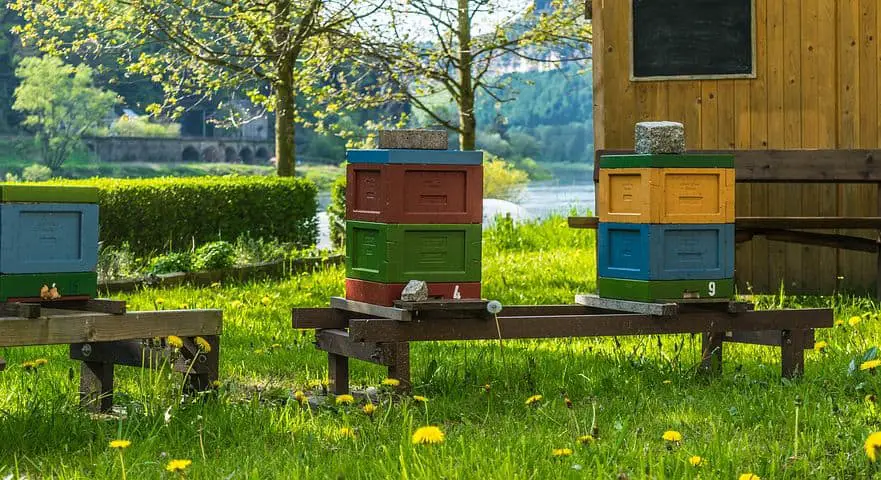Guide to sustainable beekeeping
Read our 11 principles of sustainable beekeeping

In this Guide to Sustainable Beekeeping we pu together 11 guidelines for newcomer beekeepers and also beekeeper pros. We don’t say that you have to follow all of them. We rather would like to show you the ideal situation and handling to live in harmony with bees.
1) General principle:
Keep bees for the bees’ sake and value them as pollinators first, and honey producers second.
2) The migrating principle:
Do not feed your bees exclusively with monoculture flowers. Monoculture planting requires severe pest control, carried out in most cases with synthetic pesticides & herbicides, which poison your bees.
3) The bee race principle:
In case you decide to purchase a queen bee: Become an expert about honey bee races before the purchase. However, your best choice would be to keep local bee races or likewise bee races that work well for beekeepers in your area. Read more about bee races and their traits in our Guide to honey bee races.
4) The garden principle:
Fill your garden or the surrounding environment of the hive with nectar and pollen-rich plants. Find our Guide to bee-friendly plants. If you live in South East Asia, you can also visit our Guide to bee-friendly plants in SEA. Make sure that your bees have enough foraging possibilities and/or enough food (honey resources), particularly between winter and spring and in the early summer. Of course, refrain from using synthetic pesticides on your plants.
5) The feeding principle:
Avoid using sugar-water, sugar syrup, or honey from the supermarket to feed your bees.
- The feeding of everything else than their own honey should be only practiced in absolute emergency circumstances (lack of nectar). This depends also on the climatic region in which you live. In warm climates, there should be always enough foraging possibilities, unless you have several year-long droughts.
- Differently, in cold or mountainous climates, the lack of foraging flowering plants in certain months of the year could happen more frequently.
- Acquired honey from beekeeper cooperatives or from the supermarket should never be fed to your bees. This honey could contain bacteria or viruses from other colonies that you really don’t want to have in your hives.
- Furthermore, allow bees to overwinter on their own honey instead of feeding a sugar substitute. As a rule of thumb, this means that you should leave them enough honey so that no sugar feeding is necessary.
6) The harvesting principle:
Harvest honey only if there is excess honey and when there is sufficient nectar flow.
7) The inspection principle:
Maintain the nest scent and warmth inside the bee’s home by opening the hive only if really needed.
8) The labeling principle:
Label your honey:
- Help consumers to make the difference between your high-quality product and commercial mass-market honey. Write on the etiquette where the honey has been produced and put as many details as possible about the production.
- Settle for multi-flower honey: This means that you put your hives in places where the bees ideally can find nectar and pollen from different kinds of flowers. Don’t force your bees to produce honey from just one type of flower. Instead, they should be able to choose.
- Use glass pots for the honey, not plastic.
9) The hive principle:
Choose hives that replicate natural sites used by bees, e.g. hollow trees, cavities, wooden hives. Learn more about hive types here.
10) The smoking principle:
Avoid smoking the bees, when possible and if the character or bee race allows it. The reason behind this is that smoking causes stress. Smoke produces the same escape-impulse on bees as it would to a fire approaching the hive. What happens is that bees fill their bodies with as much nectar/honey as possible: They prepare for transferring the whole hive to a new location, far away from the “fire”. This is the reason why they struggle to sting you when you open the hive after smoking it: They are literally too packed with honey, so they can’t correctly use their sting! Thus, you should at least wait a minute after you smoked. In this way, you give the bees the time to communicate the news and get prepared to fly out.
11) The hygiene principle:
Make life for parasites and diseases as difficult as possible:
- Don’t keep hives too close to each other. The minimum distance between hives should be at least 1.5 meters. If hives are stacked one on the other or side by side, infected bees could easily fail the entry of their home and contaminate another (eventually healthy) colony.
- Allow the bees to reproduce naturally by swarming. Do not cut the internal wings of your queen. By allowing the swarming, you also help to break the varroa cycle. More about swarming here.
- Follow the best practices of your local environment in terms of natural disease prevention. In some areas, formic acid is efficient against varroa. Become an expert on this topic. This includes asking more than one beekeeper of your area. Contrarily, don’t use synthetic treatments for disease and pest control (varroa mite included). Learn about natural treatments here.
We hope you enjoyed this Guide to Sustainable Beekeeping. If you have any questions or suggestions, reach out on the Bees4life Facebook page or contact us.
